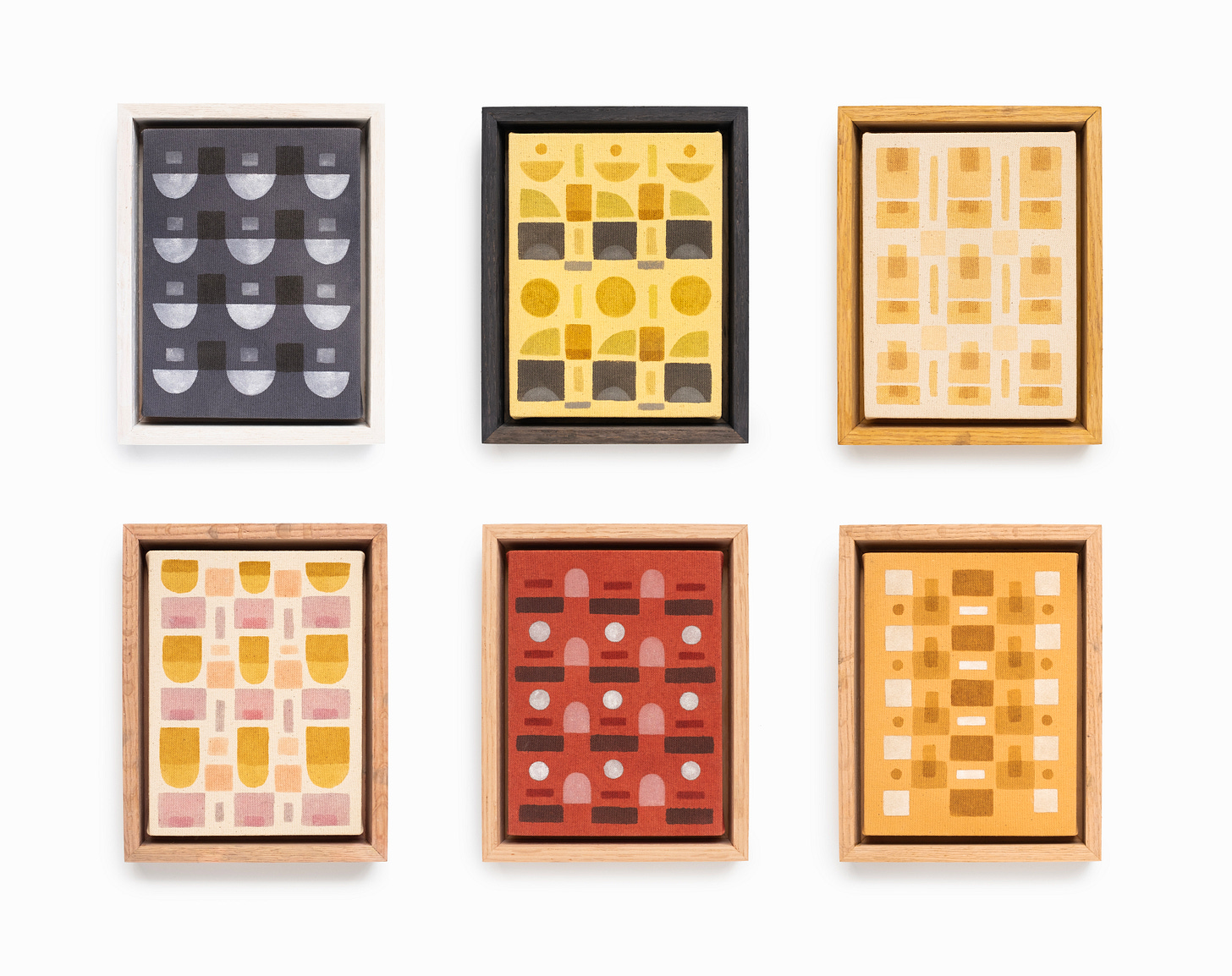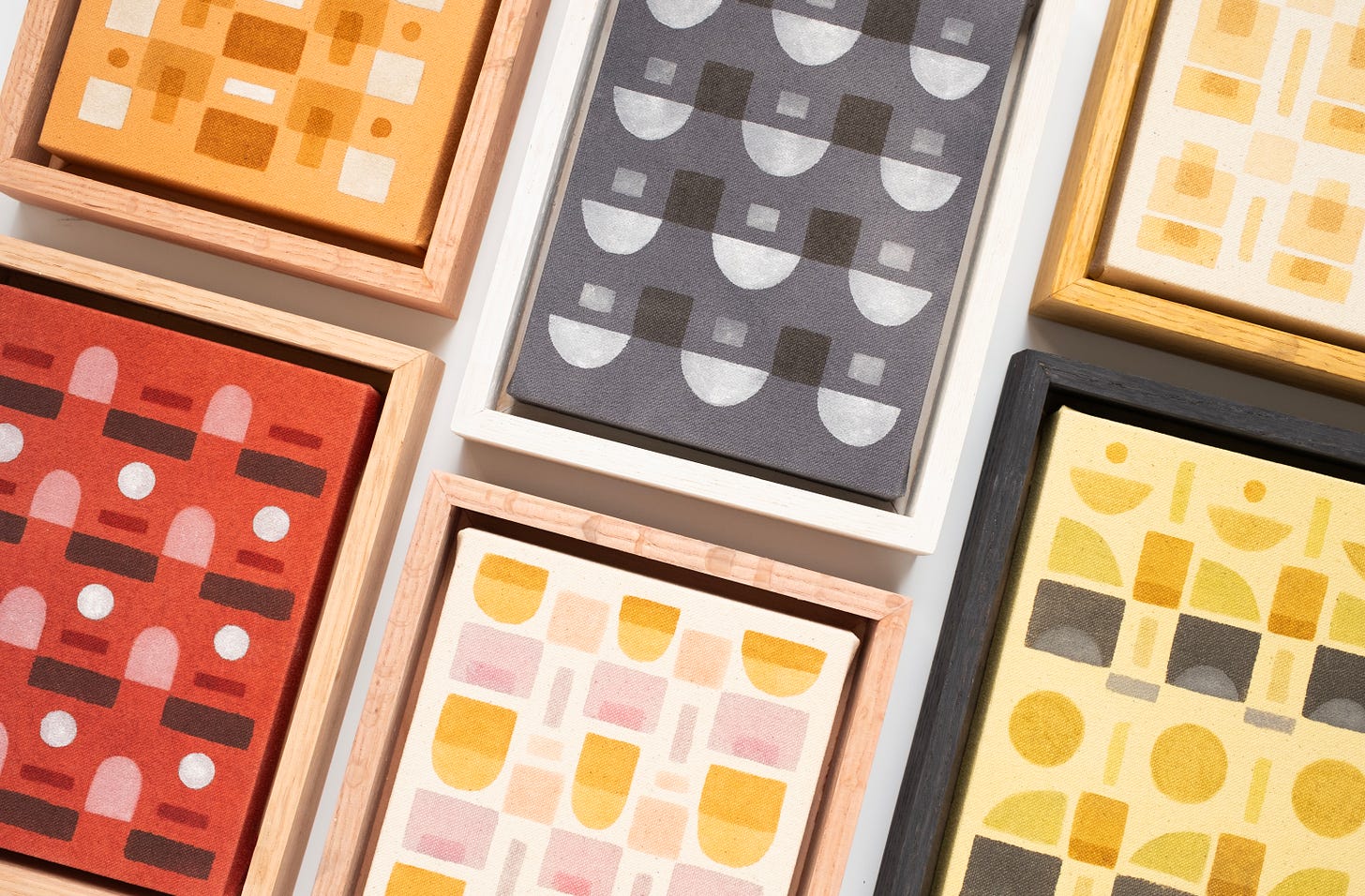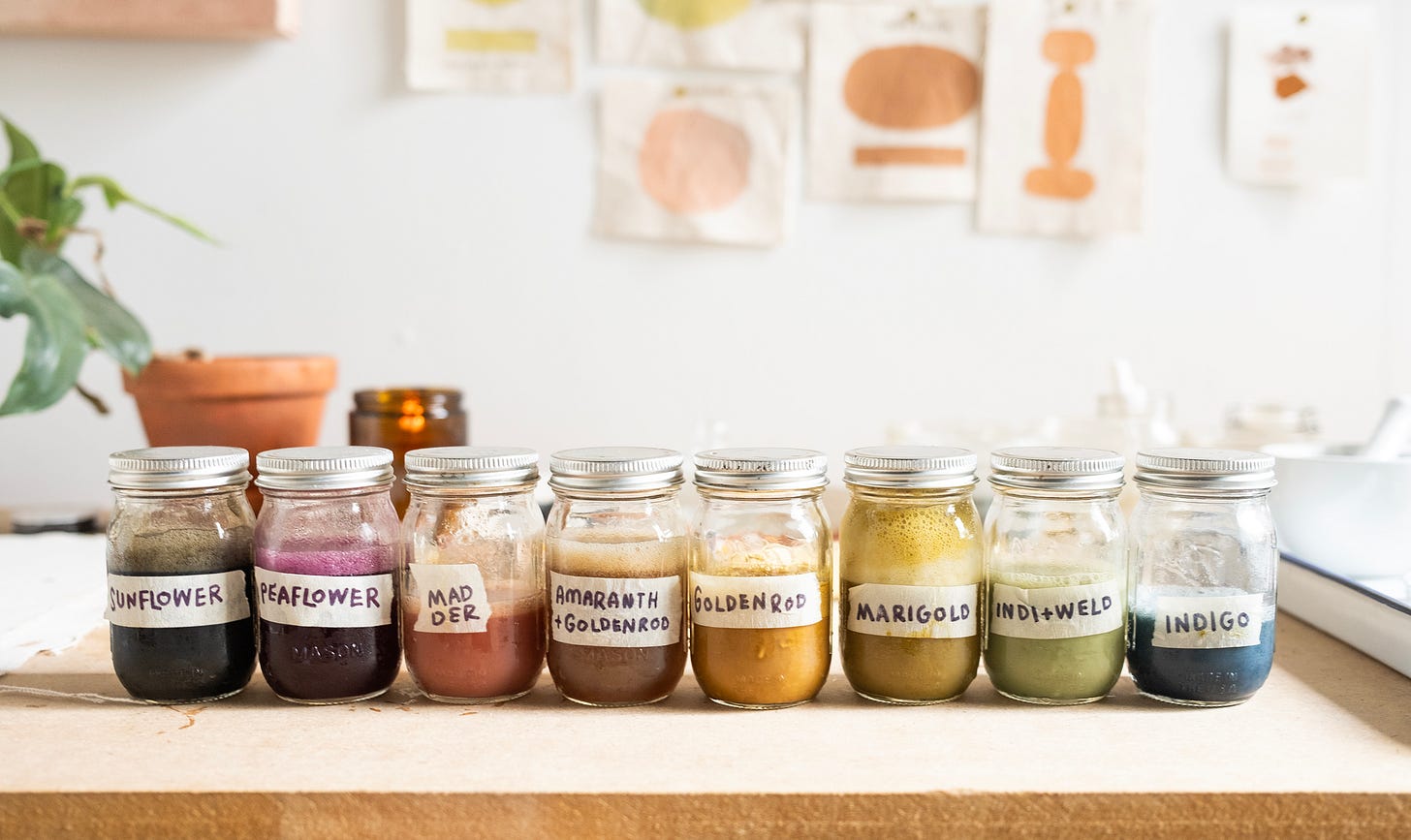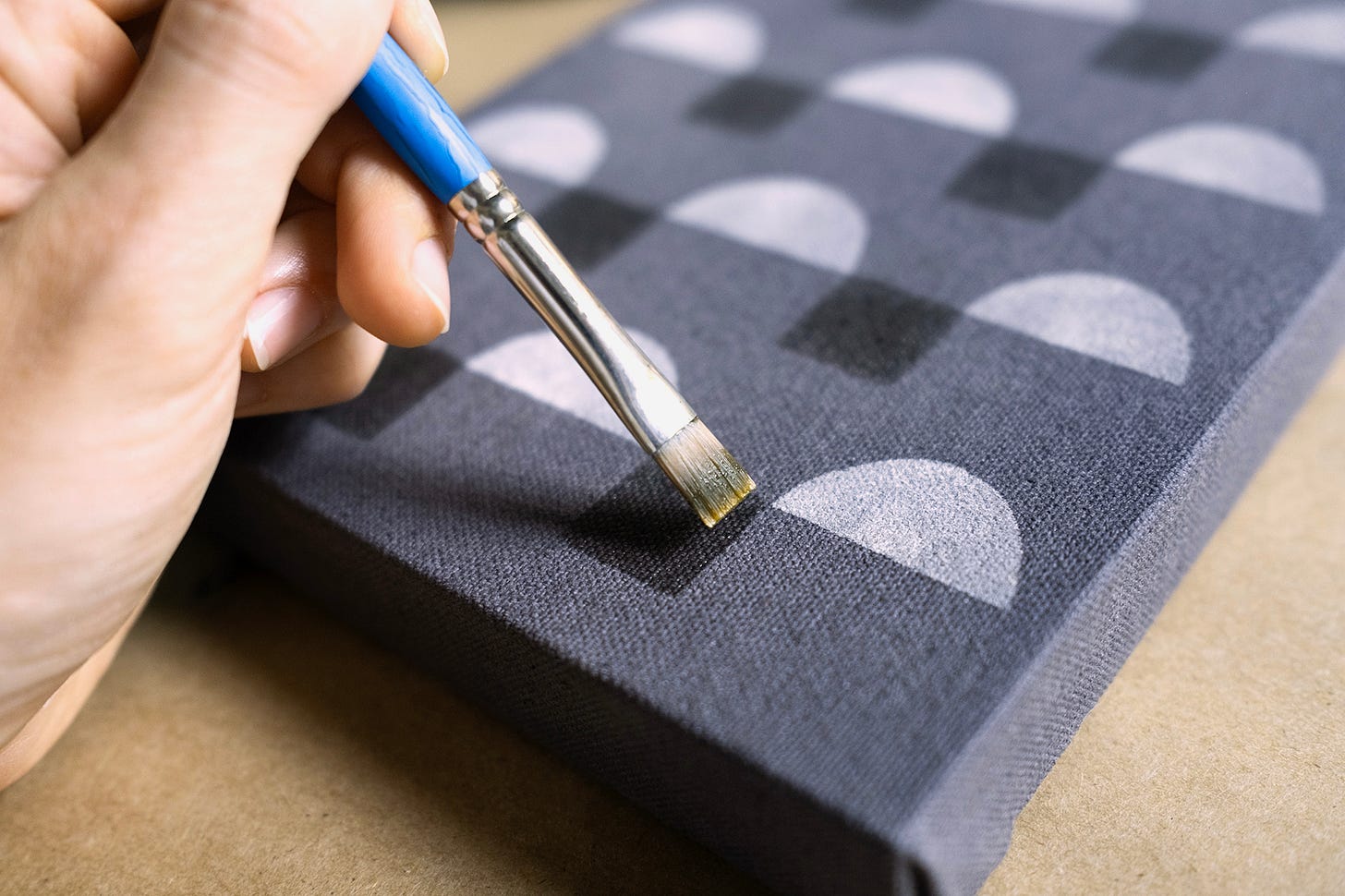I recently shipped 6 original paintings to Nahcotta - an art gallery & boutique home goods store in New Hampshire. I’m so grateful for any time my paintings get to be out and about IRL, and Nahcotta has been such a supporter of my art! (These paintings will be available here Aug 6).
In the artist form, I was prompted to write a statement about the pieces. I’m sure I was taught how to write an effective artist statement in art school, but I definitely don’t remember it, nor did I take notes, or put it into practice much.
That being said, this is not my first time writing about my work, nor am I saying it’s good or the best, but it definitely was my easiest and most enjoyable, and I think that is what is worth sharing.
The trick? Don’t overthink it. Just write freely and honestly about your process.
But of course that’s not the most practical advice! So here is one example of a formula.
Note that I didn’t follow a formula for my artist statement, but now that I see it written out, I thought I could make a formula out of it to share. Why not?
A formula
Here is a translation of my artist statement in formula format. At the bottom of this post is the actual written statement. I think I really could use the below formula as a worksheet for planning future writing about my work, so I created a simple google doc worksheet for anyone (that’s you!) to use. Access the worksheet here!
Begin with what it is in your environment you are responding to with your art.
For these paintings, I was responding to the unpredictable time I feel we are in.Discuss how you are responding to it, and why it is a response.
I discussed what things I was turning to as a response: grids create a feeling of structure, repetition, and reliability, and plants soothe me and help me stay organic, grounding me in nature and also embracing its whims.State the title and clearly and concisely what the body of work is, physically.
I stated that Summer Grids is a series of paintings.Also define it in terms of your experience creating it.
I added that this series is also an intention for healing my consciousness through contemplative processes and repetition.Briefly describe the most important facet of your process in a sentence.
The main aspect that I felt defined my process was the experience of two opposite forces: predictability as a balm, and spontaneity as evidence of nature.
Describe the materials used in your process.
I discussed my natural materials and the effect of using them.Describe the method used in your process.
I wanted to iterate how it felt to start with a grid and then let intuition and impulse take over without any plans in the process. I love experiencing how our intentions can be perfect and create order, but new things will inevitably emerge, experiments and risks arise, it’s very human and natural.
Conclude by expressing why your process facilitated your initial response to your environment and what you think the results mean to you.
I reiterated how my process met my need for creating predictability for myself by offering a structured meditative experience in relationship to pattern and the natural world, while also learning in the process that nature will always occur organically anyway, offering unplanned outcomes and interesting impulses. My hope is that the paintings offer the same effect that I felt making them.
Practical tips
Write your artist statement AFTER you make the art, NOT before.
Why? If you write it before, you might be putting too many constraints on your creative possibilities. That doesn’t mean you can’t have a plan or parameters, but I promise you, if you write it before, you’re going to learn a ton of amazing and surprising things about what the work really is about through your experience, and you’ll be re-writing it after.
Don’t make it too short.
Also, don’t make it too long.
Be yourself and use your own voice
I love reading artist statements that clearly describe someone’s experience and process. That really brings me delight. I don’t want to know how I am supposed to feel as a viewer, or the ways in which someone has deconstructed the fabric of reality and reinvented abstraction from the incongruities of metaphysics. “In the transcendent realm where the ineffable meets the tangibly elusive, my oeuvre emerges as an existential homage to the quintessence of…” Fuck that. ;-) I want to know what the artist felt and what their experience was.
You can still talk about colors and shapes and stuff!
As a counter-point to the above, don’t be shy to use “art words” like composition and repetition for example, those are perfectly descriptive and accurate! It is art, after all.
It doesn’t have to be good.
Just keep it real. Or, more importantly, make it enjoyable for you to write, and don’t put too much pressure on it. Again I don’t know if the artist statement below is good or real, or who is to even say, but I enjoyed writing it and it helped me connect with my otherwise nonverbal process verbally. It’s one of those things that I’m sure I’ll read again and make little edits to. Sometimes, I make big deals out of things that are so trivial. I’m sure it’s acceptable. I’d be happy to receive feedback if anyone out there has any more advice.
Is there something you always consider when writing about your work that I didn’t cover here? I’d love to hear the things I missed and others might like to read your comment too!
P.S. I will be making more in this series in the coming months in slightly larger sizes.

My statement in full:
In a time that is very unpredictable, I turn to two things, grids and plants. Grids create repetition, structure, and reliability, and plants soothe me away from the artificial and ground me in organic interconnectedness with nature. Summer Grids is a series of paintings and also a contemplation for healing my consciousness. The process of each piece was a meditation that included both predictability and spontaneity together. From dyeing raw canvas with botanical dyes that behave on their own terms, to painting them with paints I mix by hand from plant and mineral inks, to staining the frames with them, my process is rooted in a desire to be in relationship with nature. Many of these plants were foraged from where I live. My relationship with them is strengthened by creating patterned compositions, allowing me to experience each color and shape repetitively and intimately. I start with a simple grid of one shape and no plans. The grid feels calming and certain, but the rest unfolds without logical reason, as new shapes emerge immediately in response. The process, therefore, braids my need for predictability with the space for contemplation and the inevitable nature of moment-by-moment impulses. The result is imperfect, even with its perfect intentions, which feels distinctively human.
In case you missed it:
I shared my first Palette of the Month post on Tuesday! One subscriber got to win the painting I made with it. I am so thankful for my paid subscribers, you make my time in the studio and in writing this newsletter less anxious about space and time, and more fulfilling by keeping me super accountable and on a schedule to mix new colors, do lots of research, and make new work and new lessons to share with you each month! Subscribe below for exclusive process posts and to automatically enter the monthly giveaway.
Thank you from all corners of my heart if you have already subscribed! I am so thankful for you.





What a wonderful process to share. Great statement as well :)